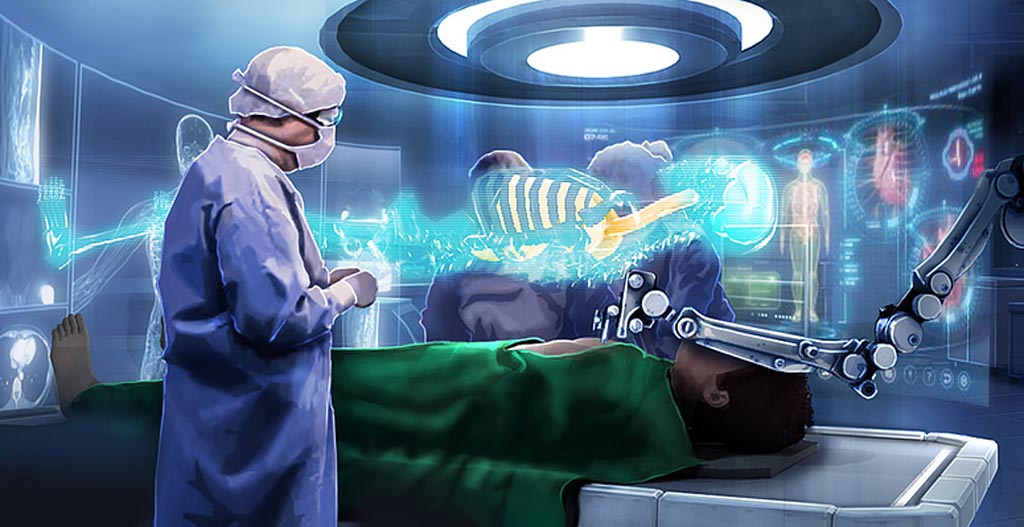Augmented Reality App Increases Biopsy Accuracy
|
By HospiMedica International staff writers Posted on 11 Apr 2018 |

Image: AR technology could soon help map the human body in real-time (Photo courtesy of UT).
Combining simultaneous localization and mapping (SLAM) and augmented reality (AR) technologies could enable rapid reconstruction of three-dimensional (3D) body sections using a smartphone.
Developed at the University of Twente (UT; Enschede, The Netherlands), the AR visualization and guidance smartphone application will display internal layers of the body on the skin surface in order to visualize invisible information. Using information collected from magnetic resonance imaging (MRI), vein-scanning devices that use laser speckle, and other sources, doctors can see the inner body segments, tumors, veins, and the status of diabetic ulcers with the use of AR. The information can be visually layered as procedure progress.
SLAM systems construct or update a map of an unknown environment while simultaneously keeping track of an agent's location within the same environment. According to the researchers, SLAM localization and 3D AR reconstruction software can be used with a multitude of imaging sensors, and not only with smartphones and their cameras, as the algorithms they developed can quickly understand 3D models of surrounding objects, regardless of the type of sensors used.
“Even though I didn't have a medical background, our common focus on SLAM and AR provides a great platform. Visual support enables doctors to oversee the situation better and make better decisions,” said senior researcher Beril Sirmacek, PhD, of the UT Robotics and Mechatronics (RAM) research group. “In a biopsy situation, this visual support can help with guiding the robot arms to reach the tumor for biopsy at the first attempt, instead of taking the off-chance and reach for the correct location by working for a whole day and making unsuccessful biopsy holes on the patient's body.”
“SLAM is a core technology in robotics, but its universal usage will only be possible if we have methods to easily interface many sensors in a robotic system,” said Professor Stefano Stramigioli, PhD, chairman of the RAM research group. “We intend to create a modular SLAM box which will automatically reconfigure itself if extra sensors are attached in a ‘Plug and Play’ fashion. Then it would be possible to connect this SLAM Box to a complete robotic system, giving it powerful perception capabilities.”
An example of functioning SLAM technology are self-driving cars, which make extensive use of highly detailed map data collected in advance. This can include map annotations such marking locations of individual white line segments and curbs on the road. Essentially, such systems simplify the SLAM problem to a simpler localization only task, perhaps allowing for moving objects such as cars and people only to be updated in the map at runtime.
Related Links:
University of Twente
Developed at the University of Twente (UT; Enschede, The Netherlands), the AR visualization and guidance smartphone application will display internal layers of the body on the skin surface in order to visualize invisible information. Using information collected from magnetic resonance imaging (MRI), vein-scanning devices that use laser speckle, and other sources, doctors can see the inner body segments, tumors, veins, and the status of diabetic ulcers with the use of AR. The information can be visually layered as procedure progress.
SLAM systems construct or update a map of an unknown environment while simultaneously keeping track of an agent's location within the same environment. According to the researchers, SLAM localization and 3D AR reconstruction software can be used with a multitude of imaging sensors, and not only with smartphones and their cameras, as the algorithms they developed can quickly understand 3D models of surrounding objects, regardless of the type of sensors used.
“Even though I didn't have a medical background, our common focus on SLAM and AR provides a great platform. Visual support enables doctors to oversee the situation better and make better decisions,” said senior researcher Beril Sirmacek, PhD, of the UT Robotics and Mechatronics (RAM) research group. “In a biopsy situation, this visual support can help with guiding the robot arms to reach the tumor for biopsy at the first attempt, instead of taking the off-chance and reach for the correct location by working for a whole day and making unsuccessful biopsy holes on the patient's body.”
“SLAM is a core technology in robotics, but its universal usage will only be possible if we have methods to easily interface many sensors in a robotic system,” said Professor Stefano Stramigioli, PhD, chairman of the RAM research group. “We intend to create a modular SLAM box which will automatically reconfigure itself if extra sensors are attached in a ‘Plug and Play’ fashion. Then it would be possible to connect this SLAM Box to a complete robotic system, giving it powerful perception capabilities.”
An example of functioning SLAM technology are self-driving cars, which make extensive use of highly detailed map data collected in advance. This can include map annotations such marking locations of individual white line segments and curbs on the road. Essentially, such systems simplify the SLAM problem to a simpler localization only task, perhaps allowing for moving objects such as cars and people only to be updated in the map at runtime.
Related Links:
University of Twente
Latest Health IT News
- Printable Molecule-Selective Nanoparticles Enable Mass Production of Wearable Biosensors
- Smartwatches Could Detect Congestive Heart Failure
- Versatile Smart Patch Combines Health Monitoring and Drug Delivery
- Machine Learning Model Improves Mortality Risk Prediction for Cardiac Surgery Patients
- Strategic Collaboration to Develop and Integrate Generative AI into Healthcare
- AI-Enabled Operating Rooms Solution Helps Hospitals Maximize Utilization and Unlock Capacity
- AI Predicts Pancreatic Cancer Three Years before Diagnosis from Patients’ Medical Records
- First Fully Autonomous Generative AI Personalized Medical Authorizations System Reduces Care Delay
- Electronic Health Records May Be Key to Improving Patient Care, Study Finds
- AI Trained for Specific Vocal Biomarkers Could Accurately Predict Coronary Artery Disease
Channels
Critical Care
view channel
AI-Powered, Internet-Connected Medical Devices to Revolutionize Healthcare, Finds Study
A new study suggests that artificial intelligence (AI)-powered, internet-connected medical devices have the potential to transform healthcare by enabling earlier detection of diseases, real-time patient... Read more
Starfish-Inspired Wearable Tech Enables Smarter Heart Monitoring
Physical movement can make it challenging for current wearable devices to accurately track heart activity. Now, a starfish’s five-arm shape has helped resolve this issue. Inspired by the starfish's ability... Read moreSurgical Techniques
view channel
New Transcatheter Valve Found Safe and Effective for Treating Aortic Regurgitation
Aortic regurgitation is a condition in which the aortic valve does not close properly, allowing blood to flow backward into the left ventricle. This results in decreased blood flow from the heart to the... Read more
Minimally Invasive Valve Repair Reduces Hospitalizations in Severe Tricuspid Regurgitation Patients
The tricuspid valve is one of the four heart valves, responsible for regulating blood flow from the right atrium (the heart's upper-right chamber) to the right ventricle (the lower-right chamber).... Read morePatient Care
view channel
Portable Biosensor Platform to Reduce Hospital-Acquired Infections
Approximately 4 million patients in the European Union acquire healthcare-associated infections (HAIs) or nosocomial infections each year, with around 37,000 deaths directly resulting from these infections,... Read moreFirst-Of-Its-Kind Portable Germicidal Light Technology Disinfects High-Touch Clinical Surfaces in Seconds
Reducing healthcare-acquired infections (HAIs) remains a pressing issue within global healthcare systems. In the United States alone, 1.7 million patients contract HAIs annually, leading to approximately... Read more
Surgical Capacity Optimization Solution Helps Hospitals Boost OR Utilization
An innovative solution has the capability to transform surgical capacity utilization by targeting the root cause of surgical block time inefficiencies. Fujitsu Limited’s (Tokyo, Japan) Surgical Capacity... Read more
Game-Changing Innovation in Surgical Instrument Sterilization Significantly Improves OR Throughput
A groundbreaking innovation enables hospitals to significantly improve instrument processing time and throughput in operating rooms (ORs) and sterile processing departments. Turbett Surgical, Inc.... Read morePoint of Care
view channel
Handheld, Sound-Based Diagnostic System Delivers Bedside Blood Test Results in An Hour
Patients who go to a doctor for a blood test often have to contend with a needle and syringe, followed by a long wait—sometimes hours or even days—for lab results. Scientists have been working hard to... Read more
Smartphone-Enabled, Paper-Based Quantitative Diagnostic Platform Transforms POC Testing
Point-of-care diagnostics are crucial for public health, offering rapid, on-site testing that enables prompt diagnosis and treatment. This is especially valuable in remote or underserved regions where... Read moreBusiness
view channel
Expanded Collaboration to Transform OR Technology Through AI and Automation
The expansion of an existing collaboration between three leading companies aims to develop artificial intelligence (AI)-driven solutions for smart operating rooms with sophisticated monitoring and automation.... Read more


















